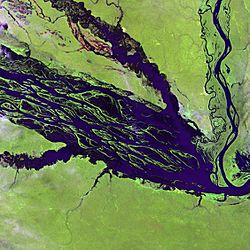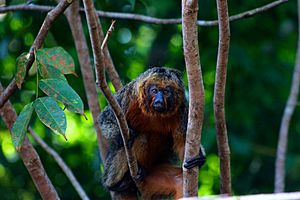Jaú National Park facts for kids
Quick facts for kids Central Amazon Conservation Complex * |
|
|---|---|
 |
|
| Country | Brazil |
| Type | Natural |
| Criteria | ix, x |
| Reference | 998 |
| Region ** | Latin America and the Caribbean |
| Inscription history | |
| Inscription | 2000 (24th Session) |
| Extensions | 2003 |
| Lua error in Module:Location_map at line 396: Minutes can only be provided with DMS degrees for longitude. | |
|
|
The Jaú National Park ('Parque Nacional do Jaú') is a huge nature reserve. It is located deep in the Amazon rainforest in the Amazonas state of Brazil.
This park is the largest forest reserve in South America. It covers more than 6 million acres (23,000 km²). Because it is a protected area, you need special permission from the Brazilian government to visit.
Jaú National Park is a great example of how to protect a tropical rainforest in the Amazon. Its forests, lakes, and rivers create a changing water world. This area is home to the most types of electric fish in the world. The park also protects many animals that are in danger. These include the giant arapaima fish, the Amazonian manatee, the black caiman, two kinds of river dolphin, and the jaguar. Many other kinds of animals and plants also live here.
Exploring Jaú National Park
The park is found near the lower part of the Rio Negro. This river is a branch of the Amazon River. The Rio Negro gets its dark color from natural materials it picks up.
During the dry season, the river has white-sand beaches. In the wet season, the forest areas become flooded. Small streams turn into large lakes, covering huge parts of the land. This is common for big rivers in the Amazon. The park also has a nine-level waterfall on the Carabinani River.
The Rio Negro flows along the eastern edge of Jaú National Park. It looks like a wide blue strip in satellite pictures. Other smaller blue lines are rivers that flow into it. The Rio Negro starts where Venezuela and Brazil meet. It then joins the main Amazon River in central Brazil. You can see islands in the middle of the river. Many of these islands disappear when the river is at its highest, between November and April.
Amazing Animals of Jaú
Jaú National Park has a huge variety of animals with backbones. Scientists have found 120 different species of mammals here. There are also 411 types of birds, 15 kinds of reptiles, and 320 different fish species.
Images for kids
See also
 In Spanish: Parque nacional del Jaú para niños
In Spanish: Parque nacional del Jaú para niños






